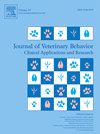Assessing Gaddi dogs as a non-lethal predator deterrent in the north-western Himalayan transhumant pastoralism
IF 1.3
3区 农林科学
Q4 BEHAVIORAL SCIENCES
Journal of Veterinary Behavior-clinical Applications and Research
Pub Date : 2025-05-01
DOI:10.1016/j.jveb.2025.04.006
引用次数: 0
Abstract
The Gaddi dog, traditionally employed as a Livestock Guard Dog by Gaddi nomads in Himachal Pradesh, India, plays a vital role in safeguarding livestock during seasonal migration. Managing approximately 70% of the state's sheep and goat population, the Gaddis face significant wildlife threats, including bears (Ursidae), snow leopards (Panthera uncia), and wolves (Canis lupus), resulting in considerable livestock losses. This study based on, data collected from 21 flocks (average sizes: 115 ± 91.90; range: 40–300 sheep and 95 ± 51.48: 20–200 goats) using structured questionnaires, assesses the behavioral traits and effectiveness of Gaddi dogs compared to non-Gaddi breeds. Analytical methods included frequency count, percentages, Likert scale, Garrett’s ranking, and Mann-Whitney U test to evaluate and compare the performance of both dog types. Findings revealed that approximately one-third of shepherds reported an increase in wildlife attacks over the past decade, with average losses of 7.31 ± 5.53 (range: 2–26) due to predation and 4.74 ± 6.40 (range: 1–30) for non-predation. Gaddi dogs demonstrated superior effectiveness in reducing livestock losses, with 23.81% of respondents reporting no losses when employing Gaddi dogs. Statistical analyses indicated Gaddi dogs outperformed non-Gaddi dogs in key behavioral attributes, including attentiveness, trustworthiness, protectiveness, and longevity, with notable differences in mean scores (p<0.05). Despite their effectiveness in reducing predation and livestock rustling, certain challenges persist, incuding high rearing costs and undesirable behaviors such as chasing vehicles and wildlife. Nevertheless, Gaddi dogs emerged as the most effective non-lethal strategy for livestock protection, contributing to reduced human-wildlife conflict and supporting conservation efforts.
评估加迪犬在喜玛拉雅西北地区作为非致命掠食者的威慑作用
传统上,印度喜马偕尔邦的加迪游牧民将加迪犬作为牲畜护卫犬,在季节性迁徙中保护牲畜发挥着至关重要的作用。加迪斯人管理着该州大约70%的绵羊和山羊,面临着严重的野生动物威胁,包括熊(Ursidae),雪豹(Panthera uncia)和狼(Canis lupus),导致相当大的牲畜损失。本研究基于21个鸡群(平均规模:115±91.90;范围:40-300只绵羊和95±51.48:20-200只山羊),采用结构化问卷,评估Gaddi犬与非Gaddi犬的行为特征和有效性。分析方法包括频率计数、百分比、李克特量表、加勒特排名和曼-惠特尼U测试来评估和比较两种狗的表现。调查结果显示,在过去十年中,约有三分之一的牧羊人报告野生动物袭击事件有所增加,由于捕食造成的平均损失为7.31±5.53(范围:2-26),而非捕食造成的平均损失为4.74±6.40(范围:1-30)。Gaddi犬在减少牲畜损失方面表现出卓越的有效性,23.81%的受访者报告使用Gaddi犬时没有损失。统计分析表明,Gaddi犬在关键行为属性上优于非Gaddi犬,包括注意力、可信赖性、保护性和寿命,平均得分差异显著(p < 0.05)。尽管它们在减少捕食和牲畜沙沙声方面有效,但某些挑战仍然存在,包括高昂的饲养成本和不受欢迎的行为,如追逐车辆和野生动物。然而,加迪犬成为保护牲畜最有效的非致命策略,有助于减少人类与野生动物的冲突,并支持保护工作。
本文章由计算机程序翻译,如有差异,请以英文原文为准。
求助全文
约1分钟内获得全文
求助全文
来源期刊
CiteScore
3.50
自引率
16.70%
发文量
107
审稿时长
325 days
期刊介绍:
Journal of Veterinary Behavior: Clinical Applications and Research is an international journal that focuses on all aspects of veterinary behavioral medicine, with a particular emphasis on clinical applications and research. Articles cover such topics as basic research involving normal signaling or social behaviors, welfare and/or housing issues, molecular or quantitative genetics, and applied behavioral issues (eg, working dogs) that may have implications for clinical interest or assessment.
JVEB is the official journal of the Australian Veterinary Behaviour Interest Group, the British Veterinary Behaviour Association, Gesellschaft fr Tierverhaltensmedizin und Therapie, the International Working Dog Breeding Association, the Pet Professional Guild, the Association Veterinaire Suisse pour la Medecine Comportementale, and The American Veterinary Society of Animal Behavior.

 求助内容:
求助内容: 应助结果提醒方式:
应助结果提醒方式:


